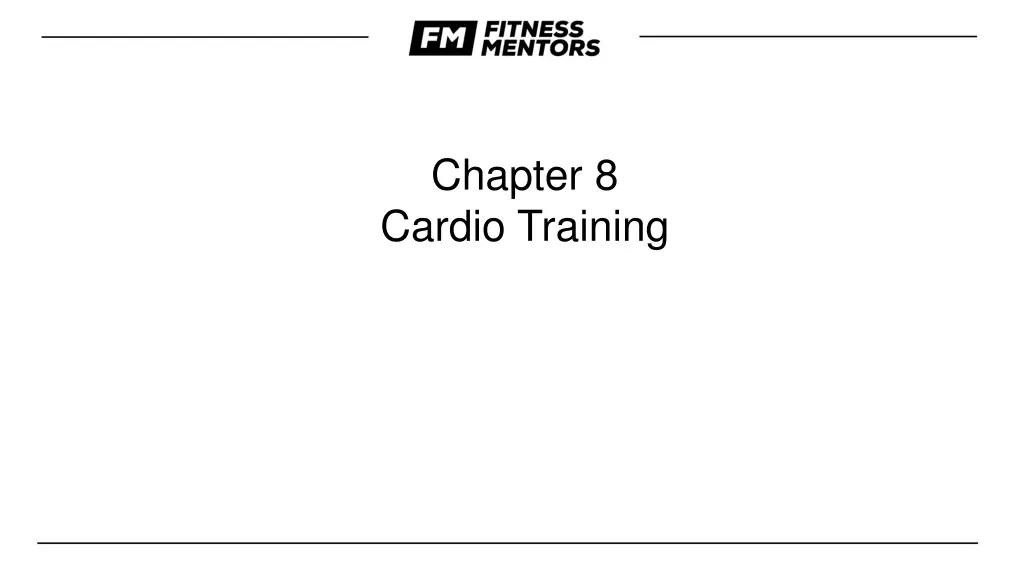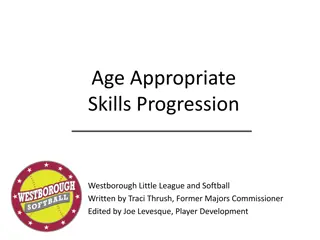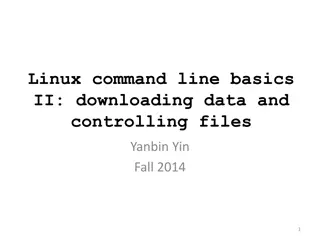
Cardio Training Essentials
Delve into the world of cardio training with this comprehensive guide covering cardio basics, cardiorespiratory fitness, integrated cardio training, programming fundamentals, warming up, conditioning, and the importance of cool-downs. Learn about the health benefits, prevention of diseases, and how to recommend cardio training for various fitness levels.
Download Presentation

Please find below an Image/Link to download the presentation.
The content on the website is provided AS IS for your information and personal use only. It may not be sold, licensed, or shared on other websites without obtaining consent from the author. If you encounter any issues during the download, it is possible that the publisher has removed the file from their server.
You are allowed to download the files provided on this website for personal or commercial use, subject to the condition that they are used lawfully. All files are the property of their respective owners.
The content on the website is provided AS IS for your information and personal use only. It may not be sold, licensed, or shared on other websites without obtaining consent from the author.
E N D
Presentation Transcript
Chapter 8 Cardio Training
Learning Outcomes What you'll be able to do: Explain the ins and outs of cardio training Understand how different systems are effected by cardio training and what it takes to work in these different systems Health benefits Know how to recommend cardio training for all types of fitness levels Teach and perform different types of cardio training
Cardio Basics Cardiorespiratory Fitness The body's ability to keep enough oxygenated blood flowing during exercise Important for health and wellness Improves ADL's
Cardio Training Integrated cardiorespiratory training Systematic progression of cardio training programs Places appropriate stress on different cardio systems at desired times for desired outcomes health benefits and prevention of disease and death
Programming Basic structure of a cardio based workout: Warm-up Conditioning Cool-down Stretch
Warming Up Prepares the body for physical activity General get the blood flowing with easy movements They do not have to be specific to the upcoming workout Specific Using movements that replicate what will be done during the workout but doing them slower and at a lower intensity
Warming up Benefits Raising body temperature Raising heart rate Psychological preparation Practical Application Cardiorespiratory portion of a warm-up should last 5 10 minutes* at a low-to-moderate intensity. It can include foam rolling and stretching as well.
Cardio Conditioning Health benefits: Better cardiac output Increases strength of heart Lowers resting HR Disease prevention
The Cool-down Eases the body back into a regular state from exercise Benefits Possible improved flexibility Cleans out waste by-products in blood produced during exercise Reduces muscle soreness Allows cardiorespiratory system to transition Reduces chance of fainting and dizziness Emotional balance and psychological recovery from exercise
Cool-down: Practical Application best for those engaging in cardio for extended periods of time: slow down and make it easy for the last 5-10 minutes Prepares body for stretching Corrective stretching (self-myofascial release and static stretching)
Benefits Benefits of Cardiorespiratory Activities or Exercise Decreases Daily fatigue Anxiety Depression Coronary artery disease (CAD) Hypertension Non insulin-dependent diabetes mellitus Cancer Osteoporosis Obesity
Mapping it Out All programs need certain guidelines FITTE factors Frequency Intensity Time Type Enjoyment
Mapping it Out Frequency How many training sessions are you doing per week? Intensity How easy or hard is the exercise program?
General Guidelines Time How long you're exerciseing Type What you're doing (running, cycling, swimming,etc...) Enjoyment how fun is it?
Determining Intensity VO2Max Peak Maximal Heart Rate (MHR) Method (Zone Training) RPE scale of 1-10 (rate of percieved exertion) RPE scale 6-20 (Borg's scale) Talk Test Method (If they can complete a sentence without taking a breath, they pass the talk test [typically used for special populations like hypertension])
Stages of Training Stage Training Different stages for different goals Important to know the heart rate for zone three*
Stage Training Stage I Target HR of 65-75% HRmax or 12-13 of RPE Can pass the talk test If a client can hold zone 1 HR for 30 minutes during 2-3 sessions per week they are ready for the next stage*
Stage 2 Training Slightly advanced clients using first and second HR zones (65 85%). Increase volume, frequency, and intensity Incorporate intervals so clients get used to raising and lowering intensity to dictate HR Training in the heart rate in Stage 2 improves the anaerobic threshold* This zone requires individuals to train near their anaerobic threshold*
Stage II Introduce interval training 5-10 min warm up in zone 1 Raise HR to zone 2 for 1 minute After the 1-minute interval, return to zone one Do it again if the client has time and can recover back into the zone one range. The most important part of the interval is to recover back to zone one in between the intervals.
Stage 3 Cardio Training Advanced clients with good cardio base Increasing volume and intensity Moving in and out of all 3 zones efficiently Increases the capacity of the energy systems needed at the power level of the OPT model.
Stage III 5-10 minute zone 1 warm up Then, increase the workload every 60 seconds until reaching zone three (86 90%).* After pushing for another minute in zone three, decrease the workload to zone two for 1 minute. If the heart rate does drop to a normal rate, overload the body again and go to zone three for 1 minute. Upon completing that minute, return to zone one for 5-10 minutes before starting over. Repeat.
Why Stage Training is Important The body adapts to exercise and we need to do more than just increasing the intensity of one exercise Manipulation of the 3 heart rate training zones can help us work at intensities we otherwise wouldn't be able to sustain for long periods of time Training at very high intensities helps us take advantage of EPOC (excess post exercise oxygen consumption)
Alternative Cardio Circuit Training Doing 3 or more resistance training exercises in succession with minimal rest between exercises Allows for a HR increase that will yield similar results as cardiorespiratory training if done properly
Alternative Cardio Sample Programs
Alternative Cardio Circuit Training Similar to cardiorespiratory training for improving fitness Has a higher post-exercise energy expenditure Body needs to repair muscles Has a similar caloric expenditure to walking at a brisk pace for same amount of time
Alternative Modes of Cardio Cardio can also be incorporated into circuit training program Sample Programs Beginner Client (Stabilization Level) 5 10 minutes Warm-up 5 10 minutes Cardiorespiratory training 15 20 minutes Circuit weight training 5 10 minutes Cardiorespiratory training 5 10 minutes Cool-down
Summary Different styles of cardio training will have different physiological effects on the body Use stage training to manipulate intensities and training zones for all levels of clients Circuit training can yield similar cardiorespiratory adaptations if done properly






















